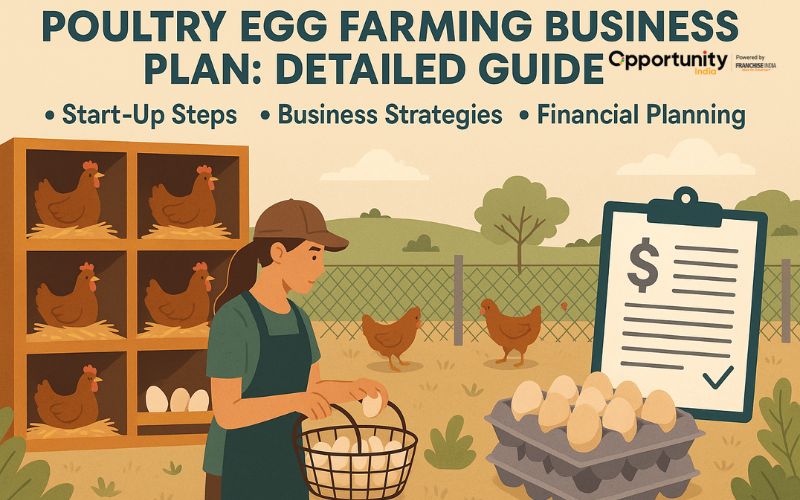
Are you considering entering the poultry egg farming industry? Excellent decision! Now is a great moment to enter this growing agribusiness as more people choose inexpensive, high-protein meals like eggs. This article will show you how to start a profitable chicken egg farm from the beginning, complete with step-by-step instructions, actual statistics, and helpful advice, regardless of whether you're a freshman farmer or a farmer trying to diversify.
Why Start an Egg Poultry Farm Business?
Growing demand for foods high in protein and expanding egg consumption in India and around the world have made poultry egg production a lucrative agribusiness venture. Egg farming offers comparatively low start-up costs, consistent revenue flow, and scalable potential for investors, agri-entrepreneurs, and rural farmers seeking a steady source of income.
Also Read: How to Start an Online Clothing Business From Home?
Chicken egg production is a profitable business because of the steady high demand for eggs in India and around the world. The egg industry offers entrepreneurs a bright future due to the world's constantly expanding population and increased knowledge of the importance of eating a diet high in protein.
With an emphasis on producing premium table eggs for the regional market, this business plan suggests starting a 1500-bird layer chicken farm. To ensure maximum egg production and bird health, the farm will manage its poultry using a contemporary, hygienic technique. Within the first 12 to 18 months of business, we want to turn a profit and build a solid reputation for healthy, fresh eggs.
One kind of layer poultry farming is egg farming, in which hens (layers) are raised especially to produce eggs. This is why it's a wise business choice:
- High Demand: Eggs are thoroughly consumed by people of all demographics, are reasonably priced, and are nutrient-dense.
- Quick Return on Investment: Layer hens begin laying eggs at 18–20 weeks of age and continue until 72–80 weeks.
- Government Assistance: Several programs (such as State Livestock Missions and NABARD) are available to poultry startups.
- Low Land Requirement: 500–1000 square feet can be used to launch a small-scale farm.

Step-by-Step Guide to Start a Poultry Egg Farm Business
Demand and Target Market
All demographics in India consume eggs, a mainstay of the Indian diet. This demand is further fueled by rising health consciousness and disposable wealth. Local customers, small merchants, eateries, and direct-to-consumer sales in neighboring towns could be the main target market. To increase reach, it's important to look into options with wholesalers.
Despite its size, the poultry business is cutthroat. To find current poultry farms, their pricing policies, and their distribution networks, carry out in-depth local market research. Offering eggs of the highest caliber, upholding stringent hygienic standards, and possibly delivering a marginally reduced pricing or value-added services (like home delivery) to provide a competitive edge.
Also Read: Top 5 Horticulture Business Ideas in India 2025
Operational Plan
Selecting the ideal site is crucial. Important things to think about are:
- Accessibility: Being close to transit lines, feed sources, and marketplaces.
- Water and Electricity: Access to electricity and water that is both economical and dependable.
- Biosecurity: A site that is isolated from other chicken farms to reduce the spread of disease.
- Space: Enough room for the manure disposal, feed storage, chicken houses, and possible future growth. We would require roughly 1200–1500 square feet for the layer shed alone, plus extra space for brooding/growing, storage, and an office, assuming that each bird had 1 sq. ft. of space.
Housing System
Consider two housing systems:
- Keeping birds on a floor covered in absorbent litter is known as the "deep litter system," which is more common. The birds will live in a more natural setting, and the waste products can be sold.
- More effective for large-scale operations, facilitating easier egg collecting and improved disease management. The initial expenditure is greater, though.
- A well-ventilated, well-lit shelter (or several smaller sheds) is essential for a farm with 1500 birds. Biosecurity, temperature control, and adequate ventilation will be given top priority in the design.
Selection of Birds
Purchase premium, day-old layer chicks from a trustworthy hatchery. Numerous strains of Rhode Island Red, White Leghorn, and other breeds renowned for their ability to lay eggs and resilience to disease are common high-producing layer breeds in India.
Feed and Nutrition
The biggest recurrent expense is feed. Purchase balanced, premium layer mash from reputable vendors. For the best egg production and bird health, a suitable feeding schedule that is modified for the several growth stages (laying, developing, and brooding) is necessary. To cut expenses, look into opportunities for buying in bulk. Keep in mind that their feed changes as they grow:
- Starter Feed (0–8 weeks) – High in protein (20–22%)
- Grower Feed (9–18 weeks) – Moderate protein (16–18%)
- Layer Feed (18+ weeks) – Balanced with calcium for strong eggshells
Management of Water
Fresh, clean water is essential. Install an effective watering system and make sure that water tanks and lines are cleaned and disinfected regularly. If a dependable water supply is not easily accessible, a borewell will be dug.
Also Read: Bamboo Farming Business in India: Process, Investment, and Profit
Waste Management
One useful byproduct is poultry manure. We will create an effective system for collecting and disposing of manure, looking into possibilities for composting or selling it to nearby farms as fertilizer.
Prevent Diseases, Don’t Just Treat Them
Sick birds are not wanted by anyone. Here's how to maintain the health of your flock:
- Observe a vaccination schedule.
- Make sure the chicken coop is dry and clean.
- Steer clear of crowds.
- Restrict the number of people who visit the property.
- Before introducing fresh birds, place them in quarantine.
There, prevention is key because an outbreak may wipe out your entire flock.
The Key Market Trends:
- Growing Per Capita Consumption: Although it is currently below global levels, India's per capita egg consumption is increasing, suggesting substantial development potential.
- Preference for Freshness: Fresh produce that is acquired locally is becoming more popular.
- Organic/Free-Range Niche: Although conventional farming is the primary emphasis at this time, there is a developing market for organic or free-range eggs that may be investigated in the future.

Investment Breakdown: Poultry Egg Farming Business Plan
Here’s a rough breakdown of what it might cost to start a 1000-layer farm:
| Expense | Estimated Cost (INR) |
|---|---|
| Poultry shed & fencing | ₹1,50,000 |
| Battery cages or equipment | ₹1,00,000 |
| 1000-layer chicks | ₹40,000 |
| Feed for 6 months | ₹2,50,000 |
| Medicine, vaccination | ₹20,000 |
| Labor (2 workers) | ₹1,20,000 |
| Water/electricity | ₹30,000 |
| Egg trays, crates, etc. | ₹10,000 |
| Miscellaneous | ₹50,000 |
| Total Investment | ₹7.7 – 8 Lakh |
Also Read: Pearl Farming in India – Process and Investment Cost
Who Buys Your Eggs?
It's time to sell those lovely things! You could:
- Provide to the nearby supermarkets or egg businesses.
- Sell directly to local customers.
- Join forces with bakeries, restaurants, hotels, or schools.
- Make use of online grocery delivery services.
- Consider weekly subscription plans for homes.
Pro Tip: Emphasize whether your farm is free-range or organic! Eggs that are ethical and clean are more expensive.
Also Read: How to Make a Profitable Hydroponic Farming Business Plan?
Wrapping Up
So, are you ready to start a poultry egg business soon with little investment? Poultry egg farming can be a reliable, scalable, and fulfilling business if you're willing to get your hands dirty and handle a live inventory (your chickens!). To begin, you don't need an enormous amount of land or a million rupees. It can develop into a full-fledged business that generates revenue with the correct preparation, cleanliness, and perseverance.

